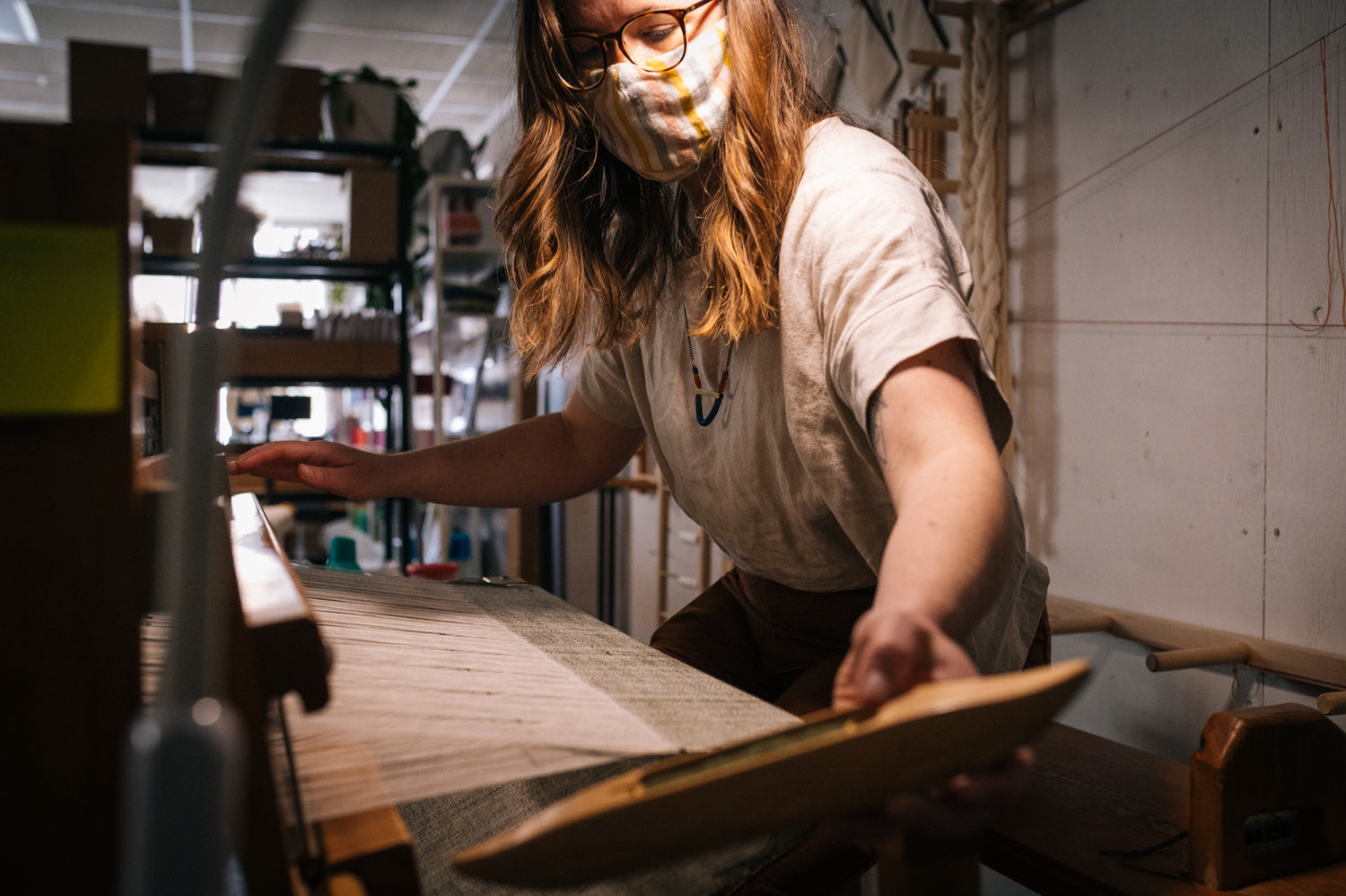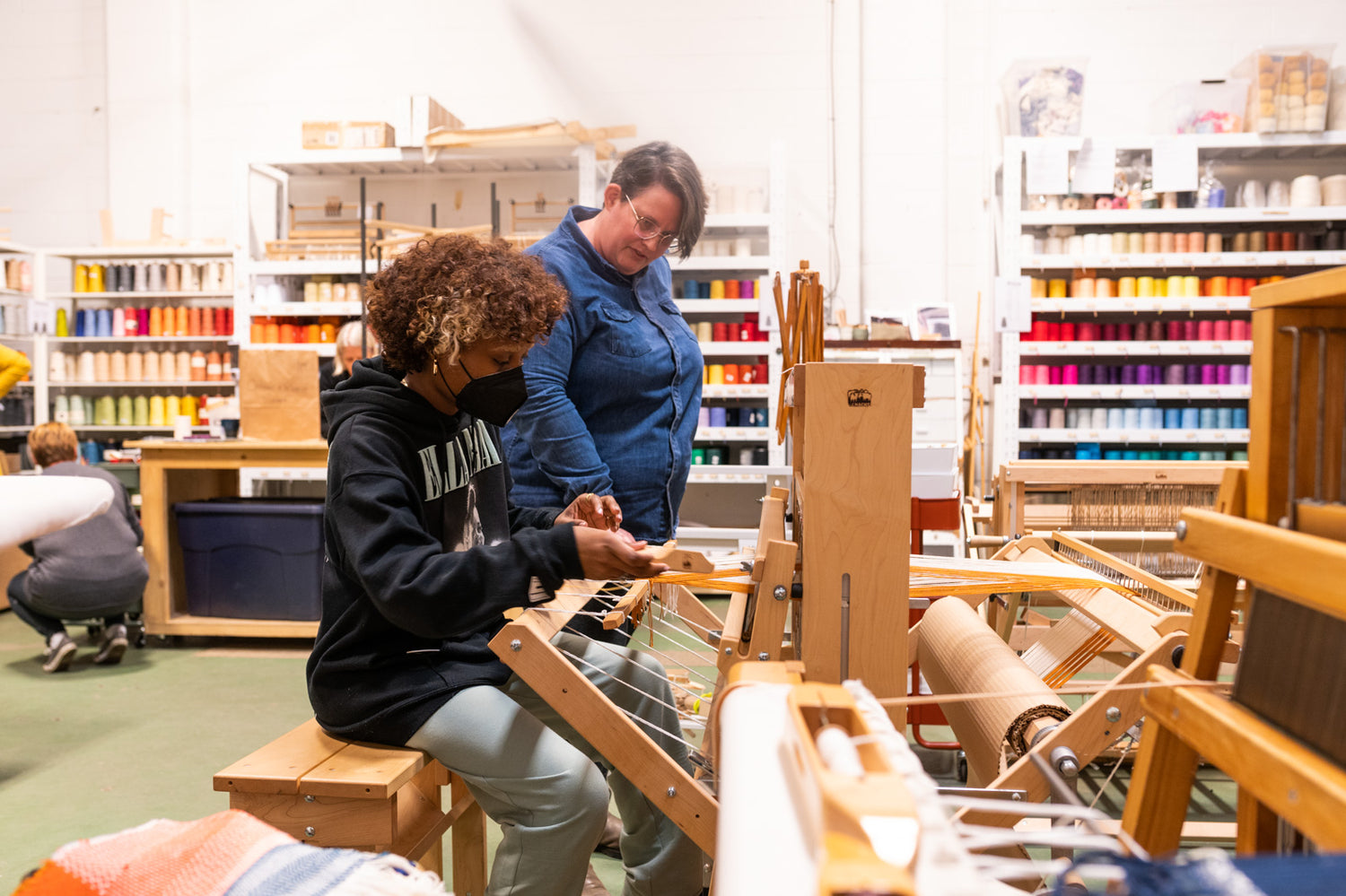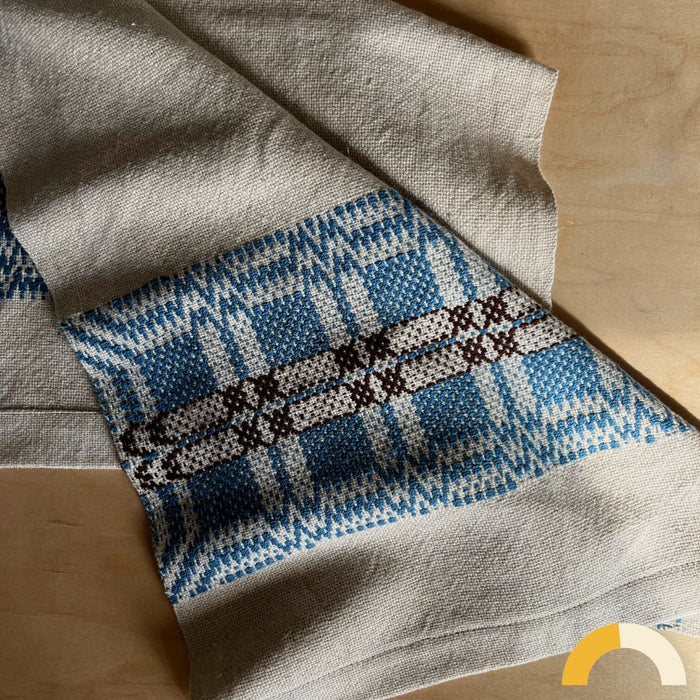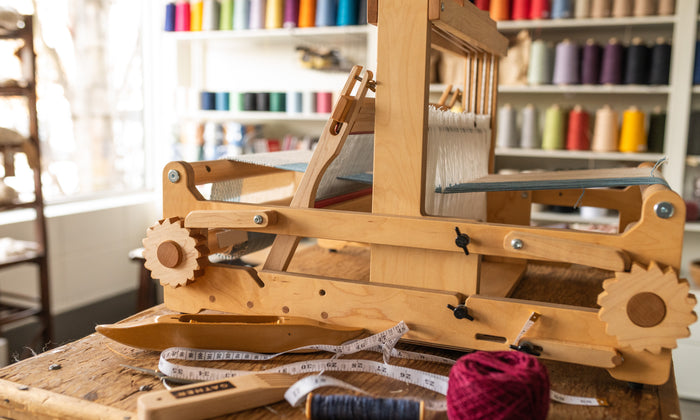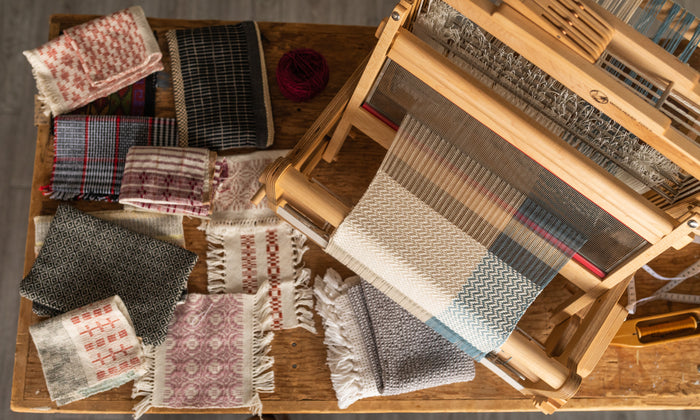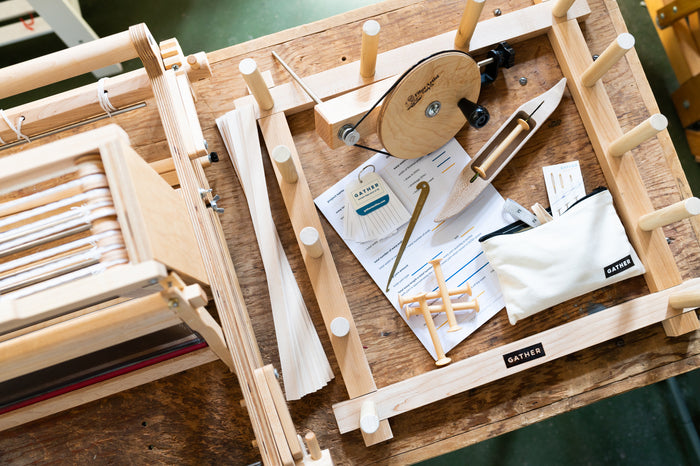You’ve done all the hard work of setting up, warping and dressing your loom.
You sit down and press a treadle (or flick a table loom lever) to throw that satisfying first pick and… nothing happens. The threads just sit there. Or maybe they open a little, but certainly not enough to throw a shuttle through comfortably. You, my friend, have a small (or missing) shed.
There are lots of things that can cause this problem, and thankfully they are all fixable. I know this because I have made at least 80% of the mistakes on this list. Let’s diagnose what’s happening in your particular case.
 First Things First. Do you have a sleying error?
First Things First. Do you have a sleying error?
Peek over your beater. When you try to open your shed, any crossed threads between the heddles and the reed will keep the shed from opening cleanly. If you see any crossed threads, you’ll need to untie the bundle of warp ends those threads are in, re-sley them so they are no longer crossed, and tie back on.
Do you have a threading error?
If everything is looking good between the heddles and the reed, look a little further back between the heddles themselves. Any crossed threads or funny things happening here? If you find them, check out our post on How to Fix a Threading Error.
Is your warp going over the back beam?
If your warp is going straight from the warp beam to the heddles without going over the back beam first, you will not be able to open a shed at all. If your back beam is removable (like on a Schacht Wolf loom or a Leclerc Nilus), simply loosen the tension on your warp, remove the back beam, slip it underneath the warp ends, put it back in, and you’re off to the races. If your back beam is not removable (as on most table looms) I am so sorry to inform you that you need to unthread your warp, pull it back and over the back beam, then re-thread and re-sley. Alternatively, you could wind the warp fully forward onto the cloth beam, cut your warp on the warping rod and retie it correctly over the beam.
Checking Your Tension and Advancing Your Warp
Ok, so it’s not a sleying or threading error and you remembered to go over the back beam. Let’s look at your overall warp set up to see if there are any issues, starting with tension. Good tension is firm and even. When you press down on a warp that has good tension, it will have a bit of bounce to it.
Is your tension uneven? Press your warp with the palm of your hand. Are there parts that feel softer and parts that feel harder? Are any sections significantly tighter than the others? If your tension is severely uneven, try untying your warp and re-tying it (or lashing it on) with more even tension. Your overall warp will not be able to get good tension if a few extremely tight threads are keeping you from tightening the overall tension to where it needs to be.
Can you tighten your tension? If yes, give it a few more clicks (but stop if it feels like you’re going to break any threads!). Loose tension can cause a ‘mushy’ shed. Tightening it up might help. If no, you can’t tighten it any more, try loosening it up just a little bit. Over-tight tension can make it hard to lift shafts, and can make a shed clean but small.
Have you woven an appropriate header?
If you’re a beginner or you’re weaving on a new-to-you loom, the first couple of sheds might look scary. See if you can weave through the initial unevenness. The issues might disappear once you’ve woven your header.
While you’re checking out your tension and investigating any tension issues, it’s a good idea to check and see if there’s anything keeping your warp from advancing smoothly.
Can you advance your warp?
This actually might be all you need to do to improve your shed. Sheds get smaller the closer you get to the heddles. Make sure you’re weaving in the “sweet spot” for your loom… usually a few inches beyond your front beam. Advance your warp every 3 inches or so of weaving, and don’t try to weave as far as you can possibly go before advancing!
If you can’t advance your warp, it’s time to walk around to the back of your loom and check out what’s going on back there.
Are your lease sticks getting in the way?
If you leave your lease sticks in while you weave, they need to be pushed towards the back beam of your loom. If they’re up right behind the heddles, they will torpedo your shed. On small looms without much distance between the heddles and the back beam (like the Leclerc Dorothy and other shallow table looms) the lease sticks need to be removed during weaving to get a good shed.
Do you have any tangles behind the heddles?
A few crossed threads between the heddles and the back beam aren’t the end of the world. But if there are lots, or if a handful merge together into a bit of a rat’s nest, they can pile up behind the heddles and keep your shafts from lifting. If you see any tangles, gently work them back away from the heddles towards the back beam. You will need to keep doing this every time the tangle gets up to the heddles as you advance your warp.
Are your apron rods pulled to one side?
If an apron rod on your warp beam or your cloth beam is pulled out a few inches to one side, it can get stuck. This happens when the apron rod grinds against the wood frame of the loom, catches on the break mechanism, or gets caught in the mechanism that advances the warp. This can keep you from adjusting your tension and/or advancing your warp, both of which can hurt your shed. Release tension and see if you can gently pull the apron rod away from what it’s catching on. You may need to untie your warp to adjust it if it’s really causing troubles.
Giving your Loom a Physical Exam
We’re getting deep into shed troubleshooting now. If the issue isn’t with how you’ve dressed your loom with this particular warp, the issue may be with the loom itself. These steps are particularly important if you are using a loom that you haven’t used before, if you’ve recently moved or disassembled your loom, or if you’ve never been able to get a good shed on this particular loom before.
Is there anything between the top of the shafts and the castle? Let’s start at the top. Look above your shafts at the gap between them and the castle of your loom (if it has one). Is there anything there that might be preventing the shafts from rising cleanly? A lamp or a bobbin winder clamped to the castle, perhaps? Anything sticking out of the loom frame or castle that might get in the way?
What about under the shafts? Is there anything caught beneath the shafts that’s keeping them from settling comfortably into their holders? Maybe a rogue screwdriver or that sley hook you thought you lost forever?
Are the shafts catching on each other? Look down at the shafts from above, and try to change the shed a few times. Are the shafts catching or leaning on each other in a way that is keeping them from lifting and lowering? Different looms have different ways of keeping shafts separate. Some use pegs, some use metal tracks that the sheds slide along in. See if your loom has any broken or damaged parts in this area that might need repair.
Are the heddles organized nice and neatly? The top and bottom eye of each heddle should be on the same shaft. If you have a heddle connected to two different shafts, it will cause problems. Same goes for a heddle that’s only connected at the top or bottom, but is hanging halfway free. This can snag on another shaft and interfere with the shed.
Are your tie-ups in place and working correctly? Time to get down on the floor! Check where your treadles connect to the lamms. Are the cords connected to the right treadles? Have any knots, pegs, or clasps slipped out of place? Press each treadle in turn with your hand and see if the correct shafts are being lifted.
Are you using the right length of tie-up cords? I can hear you thinking “Wait, there are different lengths of tie-up cords?!?” Yes, there are. Each manufacturer uses something slightly different, and some manufacturers use different lengths for different loom models (Leclerc has three!). If your tie-up cord is too long, it won’t lift the shafts as high as it should and you won’t get a good shed. If you got your loom second-hand, or if you have replaced or altered the tie-up cords at any point, this is worth checking. Measure your cords, then hit the manufacturer’s website to see what length of cord your loom is supposed to have.
Is the beater bar at an appropriate height? Some looms have adjustable beaters. Your warp should be coming through the reed right at the bottom, next to the shuttle race. If your warp is above the shuttle race, adjust your beater upwards. This will improve your shed.
Are your shafts heavy enough? On a jack loom, inactive shafts sit still while others are raised. If these inactive shafts are too light, they will sit higher than intended, eating up some of your shed. Press the top of your shafts with your hand. If you can move them down more than a quarter inch or so, you may want to consider weighting your shafts with some thin strips of metal. This is especially worth investigating if you have made your shafts lighter in any way, by altering or replacing them, or by swapping your heddles to texsolv.
It’s Not Me, It’s You
Whew! Ok! If you’ve gotten all the way to the end of this piece and absolutely everything about your loom, your warp, and how the loom was dressed is absolutely perfect and you still can’t get a good shed, the problem might be with how you’re approaching your project.
What’s your sett like? The denser the sett, the trickier the shed. This is especially true with ‘sticky’ warp yarn--yarn where strands grab onto their neighbours like velcro. Check a sett chart to see if you’re pushing beyond the limits of the recommended sett for the yarn you’re using. Consider re-sleying at a looser sett if needed.
Are you using an appropriate shuttle? A table loom might be set up absolutely perfectly and dressed with impeccable tension, and it’s still not going to have a shed large enough for a large rag shuttle. If you’re using a loom that just naturally has a small shed, try switching to a slim shuttle and seeing if that makes life easier.
Are you over-filling your bobbins? This is a bad habit of mine. I make big, fluffy bobbins that look like fat little cocoons. Then when I go to weave, the bobbin catches on the threads on the top of the shed and causes all sorts of problems. Hold your shuttle at eye level and look across the top of it. Is your bobbin yarn poking up well above the shuttle? If it is, the problem might be with the bobbin, not the shed. Try winding a skinnier bobbin and see if it helps.
It’s Still Not Working
Well, here we are at the end of the post. If your shed still isn’t wide enough, congratulations! You are breaking new and unexplored territory and advancing our knowledge of shed issues. But seriously, there are certainly things that we haven’t anticipated here. Go through the list one more time for good measure, then by all means send us an e-mail or set up some teaching time. Weaving is too important to let something as small as a tiny shed get in your way!

